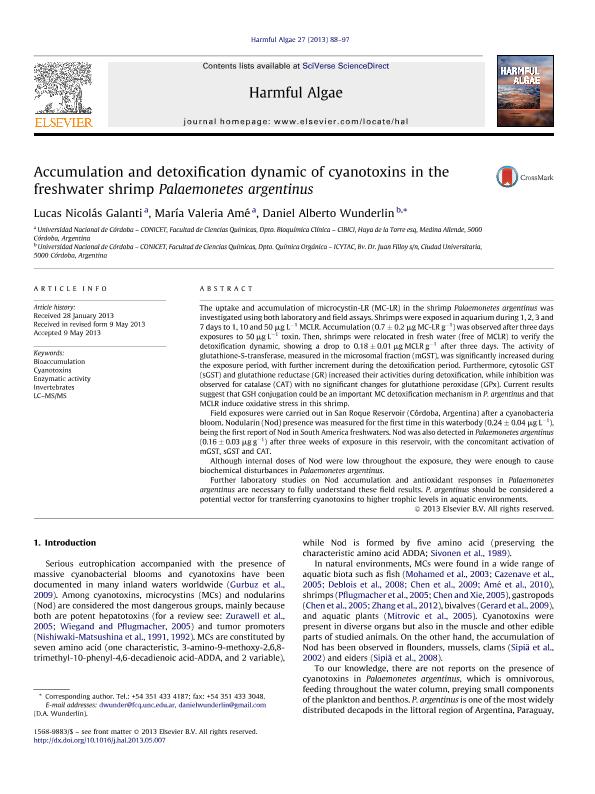Artículo
Accumulation and detoxification dynamic of cyanotoxins in the freshwater shrimp Palaemonetes argentinus
Fecha de publicación:
07/2013
Editorial:
Elsevier Science
Revista:
Harmful Algae
ISSN:
1568-9883
Idioma:
Inglés
Tipo de recurso:
Artículo publicado
Clasificación temática:
Resumen
The uptake and accumulation of microcystin-LR (MC-LR) in the shrimp Palaemonetes argentinus was investigated using both laboratory and field assays. Shrimps were exposed in aquarium during 1, 2, 3 and 7 days to 1, 10 and 50 mg L1 MCLR. Accumulation (0.7 0.2 mg MC-LR g1 ) was observed after three days exposures to 50 mg L1 toxin. Then, shrimps were relocated in fresh water (free of MCLR) to verify the detoxification dynamic, showing a drop to 0.18 0.01 mg MCLR g1 after three days. The activity of glutathione-S-transferase, measured in the microsomal fraction (mGST), was significantly increased during the exposure period, with further increment during the detoxification period. Furthermore, cytosolic GST (sGST) and glutathione reductase (GR) increased their activities during detoxification, while inhibition was observed for catalase (CAT) with no significant changes for glutathione peroxidase (GPx). Current results suggest that GSH conjugation could be an important MC detoxification mechanism in P. argentinus and that MCLR induce oxidative stress in this shrimp. Field exposures were carried out in San Roque Reservoir (Co´ rdoba, Argentina) after a cyanobacteria bloom. Nodularin (Nod) presence was measured for the first time in this waterbody (0.24 0.04 mg L1 ), being the first report of Nod in South America freshwaters. Nod was also detected in Palaemonetes argentinus (0.16 0.03 mg g1 ) after three weeks of exposure in this reservoir, with the concomitant activation of mGST, sGST and CAT. Although internal doses of Nod were low throughout the exposure, they were enough to cause biochemical disturbances in Palaemonetes argentinus. Further laboratory studies on Nod accumulation and antioxidant responses in Palaemonetes argentinus are necessary to fully understand these field results. P. argentinus should be considered a potential vector for transferring cyanotoxins to higher trophic levels in aquatic environments.
Palabras clave:
BIOACCUMULATION
,
CYANOTOXINS
,
ENZYMATIC ACTIVITY
,
INVERTEBRATES
,
LC-MS/MS
Archivos asociados
Licencia
Identificadores
Colecciones
Articulos(CIBICI)
Articulos de CENTRO DE INV.EN BIOQUI.CLINICA E INMUNOLOGIA
Articulos de CENTRO DE INV.EN BIOQUI.CLINICA E INMUNOLOGIA
Articulos(ICYTAC)
Articulos de INST. DE CIENCIA Y TECNOLOGIA DE ALIMENTOS CORDOBA
Articulos de INST. DE CIENCIA Y TECNOLOGIA DE ALIMENTOS CORDOBA
Citación
Galanti, Lucas Nicolás; Amé, María Valeria; Wunderlin, Daniel Alberto; Accumulation and detoxification dynamic of cyanotoxins in the freshwater shrimp Palaemonetes argentinus; Elsevier Science; Harmful Algae; 27; 7-2013; 88-97
Compartir
Altmétricas




